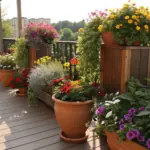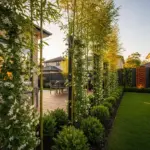5. Zen Garden Patio Retreat

After years of entertaining-focused outdoor spaces, I found myself craving something completely different. The constant noise, the busy schedules, the endless to-do lists – I needed a place to just breathe.
That’s when I discovered the concept of a zen garden patio retreat. A space designed purely for peace and reflection, not parties or barbecues.
Creating this sanctuary became my most meaningful project yet, even though it challenged everything I thought I knew about outdoor design.
Choosing Natural Materials That Feel Authentic
My first mistake was thinking I could fake the zen aesthetic with synthetic materials. I bought composite “bamboo” fencing and artificial stone pavers thinking they’d be easier to maintain.
The space felt like a cheap spa knockoff.
Natural materials are absolutely essential for authentic zen design. Real bamboo, genuine stone, and natural gravel create textures and energy that you simply can’t replicate.
I started over with natural bamboo screening from a specialty supplier. It cost three times more than the fake stuff, but the difference was incredible – each piece had unique grain patterns and natural color variations.
For stone elements, I chose river rocks and slate stepping stones with smooth, weathered surfaces. The key is finding stones that feel good under your bare feet and have that water-worn softness.
Natural gravel was trickier than expected. I initially bought standard pea gravel from the hardware store, but it was too uniform and bright. Real zen gardens use carefully selected stones in varying sizes and muted colors.
I ended up sourcing decomposed granite and small river pebbles from a Japanese garden supplier. More expensive? Yes. Worth it for the authentic feel? Absolutely.
The total material cost was about 40% higher than synthetic alternatives, but the sensory experience is completely different.
Creating a Meditation Corner That Actually Works
I thought I could just plop a cushion anywhere and call it a meditation space. Wrong again.
Meditation seating needs to be positioned thoughtfully – facing away from distractions, with a view of something peaceful, and at the right height for comfort.
My first setup faced the neighbor’s air conditioning unit. Not exactly conducive to inner peace.
I ended up creating a dedicated meditation corner in the far corner of my patio, facing my small fountain and bamboo screen. The positioning blocks out street noise and creates a sense of enclosure.
For seating, I tried traditional meditation cushions first, but my knees couldn’t handle sitting on the ground for more than five minutes. Getting old is real.
I found this amazing low teak bench that’s the perfect height for comfortable meditation. It’s weather-resistant and develops a beautiful silver patina over time.
The key is having multiple seating options. I keep waterproof meditation cushions stored nearby for guests who prefer floor seating, plus a small side table for tea or a journal.
I also added a small storage box disguised as a stone for keeping meditation supplies – cushions, blankets, and even a small bell for timing sessions.
Japanese-Inspired Plants for Authentic Atmosphere
This is where I got really excited and almost ruined everything. I went to the nursery and bought every “Japanese” plant I could find without considering growth habits or maintenance needs.
Six months later, I had a jungle instead of a zen garden.
Bamboo is essential, but choosing the right variety is crucial. I learned this when my first bamboo planting tried to take over my entire yard. Clumping bamboo, not running bamboo – trust me on this.
I went with Fargesia bamboo, which stays contained and creates beautiful vertical lines without becoming invasive. It rustles gently in the breeze, adding natural sound therapy.
Ornamental grasses provide movement and texture without overwhelming the space. I use Japanese forest grass in shaded areas and fountain grass where there’s more sun.
The secret is restraint. A few well-chosen plants have much more impact than cramming in every Japanese species you can find.
I also added moss in shaded areas between stepping stones. It took two years to establish properly, but now it creates this incredible soft carpet that feels ancient and peaceful.
Hostas and ferns fill in the understory without competing for attention. The goal is creating layers of green in different textures, not a riot of colors and flowers.
Installing a Small Fountain for Tranquility
Water features in zen gardens serve a completely different purpose than in other outdoor spaces. This isn’t about making a statement – it’s about creating soothing sounds for meditation.
My first fountain was way too big and loud. The sound was more “rushing river” than “gentle brook,” which was actually distracting during quiet moments.
I replaced it with a small stone basin fountain that creates just enough water sound to mask background noise without overwhelming the space.
The fountain is positioned where I can see it from my meditation bench but not so close that the sound dominates. Placement is everything in zen design.
I chose a simple design – water bubbles up through a natural stone and flows into a shallow basin filled with smooth river rocks. The sound is gentle and consistent.
Maintenance is minimal, which is perfect for a zen space. I clean the pump monthly and add water as needed. The simple design means fewer things can go wrong.
The electrical work required running a weatherproof outlet, which cost about $300 for professional installation. Worth every penny for the peace of mind and safety.
Designing Pathways with Stepping Stones
Stepping stone pathways in zen gardens aren’t just functional – they’re meant to slow you down and make you mindful of each step.
I initially spaced my stones for normal walking pace, which completely missed the point. You’re supposed to walk slowly and deliberately.
The proper spacing forces you to be intentional about each step. I placed my natural slate stepping stones about 18 inches apart, which creates a naturally slower, more meditative pace.
The pathway winds gently through the space rather than taking the most direct route. This isn’t about efficiency – it’s about the journey being as important as the destination.
I surrounded each stepping stone with decomposed granite and small river pebbles. The different textures feel amazing underfoot and create visual interest.
Moss has naturally filled in around some of the older stones, which adds to that timeless, established feeling that zen gardens are known for.
The key is making the pathway feel inevitable, like it’s always been there. No sharp turns or awkward angles – just a gentle flow that guides you naturally through the space.
Creating a Peaceful, Low-Maintenance Space
Here’s the truth about zen gardens – they require a different kind of maintenance than traditional landscapes. Less frequent but more mindful.
Raking the gravel areas is actually meditative, not a chore. I do it weekly as part of my morning routine, and it’s become one of my favorite quiet moments.
Pruning is minimal but precise. The goal is maintaining clean lines and natural shapes, not forcing plants into unnatural forms.
Weeding happens regularly but gently. I hand-pull anything that doesn’t belong, which keeps me connected to the space and aware of changes.
The bamboo screening needs occasional cleaning and tightening, but it’s held up beautifully for three years with minimal care.
Water feature maintenance is just monthly pump cleaning and keeping the basin free of debris. Simple systems require less intervention.
The biggest maintenance tip? Embrace imperfection. Zen gardens are supposed to show the passage of time and seasons. A few fallen leaves or natural weathering adds character.
I spend about 30 minutes per week maintaining the space, but it feels like meditation rather than work. That’s exactly what I was hoping for.
Ready to become the ultimate host with an Entertainment-Ready Multi-Level Patio that’ll make your backyard the neighborhood gathering spot? Click “next” below to discover how different elevation zones and built-in features can transform any outdoor space into party central – plus I’ll share the lighting disaster that taught me everything about outdoor electrical safety!









GIPHY App Key not set. Please check settings